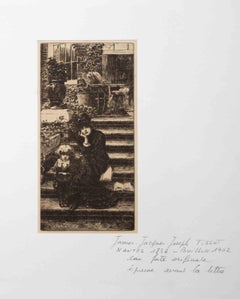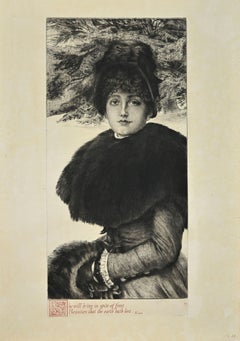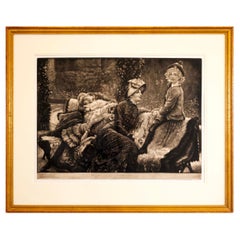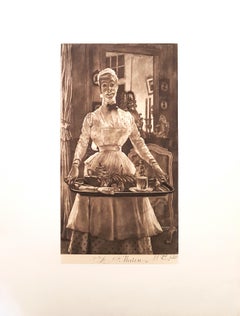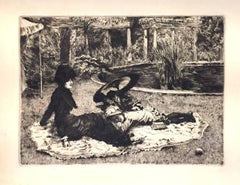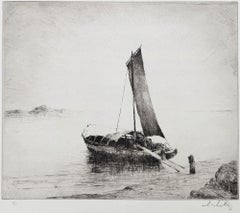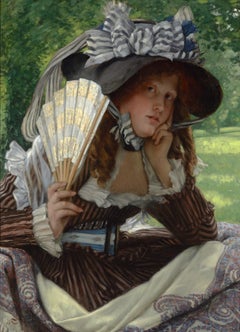James Tissot Art
French, 1836-1902
James Jacques Joseph Tissot (October 15, 1836 - August 8, 1902) was a French painter. Tissot was born at Nantes. He studied at the Êcole des Beaux-Arts in Paris under Ingres, Flandrin and Lamothe, and exhibited in the Paris Salon for the first time at the age of twenty-three. In 1855 Tissot moved to Paris where he studied under Jules-Élie Delaunay, Louis Lamothe and Hippolyte Flandrin. Lamothe, who had been a pupil of Ingres, introduced him to Edgar Degas. The two men became close friends. Another friendship formed at this time was with James McNeill Whistler. Two portraits, including one of Tissot's mother, were among the artist's first exhibits at the Paris Salon in 1859. In 1861 he showed The Meeting of Faust and Marguerite, which was purchased by the state for the Luxembourg Gallery. His first characteristic period made him a painter of the charms of women. Demi-mondaine would be more accurate as a description of the series of studies that he called La Femme à Paris.
Tissot fought in the Franco-Prussian War, and, falling under suspicion as a Communard, left Paris for London. Here he studied etching with Sir Seymour Haden, drew caricatures for Vanity Fair, and painted portraits as well as genre subjects. Sometime in the 1870s Tissot met a divorcée, Mrs. Kathleen Newton, who became his muse and the model for many of his paintings.to
2
3
2
6
5
3
1
Querelle d'amoureux. (Quarreling). 1
By James Tissot
Located in Storrs, CT
En plein soleil. (In the Sunlight). 1881. Etching and drypoint. Tissot 54, Béraldi 45, Wentworth 54. 7 13/16 x 11 1/2 (sheet 11 1/4 x 15). Edition about 100. Mat line and two hinge s...
Category
19th Century Impressionist James Tissot Art
Materials
Drypoint, Etching
$2,800 Sale Price
20% Off
Girl and Child - Etching by James Tissot - Late 19th Century
By James Tissot
Located in Roma, IT
Girl and Child is an original Modern artwork realized by James Tissot, in full James-Joseph-Jacques Tissot, (born Oct. 15, 1836, Nantes, France—died Aug. 8, 1902, Buillon Abbey, near...
Category
Late 19th Century Modern James Tissot Art
Materials
Paper, Etching
Promenade dans la Neige - Etching by J. Tissot - 1880
By James Tissot
Located in Roma, IT
Beautiful print on verge crème, 2° state on 3, with letters printed in red. Stamp “Lugt 1545”.
Little crack and fold on lower left margin of the sheet.
Some small traces of oxidati...
Category
1880s Post-Impressionist James Tissot Art
Materials
Drypoint, Etching
James Tissot Le Banc de Jardin Mezzotint Etching on Paper Beraldi 66 Edition
By James Tissot
Located in Keego Harbor, MI
A realism style mezzotint etching on paper titled “Le Banc de Jardin (The Garden Bench)” by French artist James Tissot. Signed in the plate. From the Beraldi 66 edition, 1st state. P...
Category
20th Century French James Tissot Art
Materials
Paper
Le Matin - Etching by James Tissot - 1886
By James Tissot
Located in Roma, IT
Wonderful mezzotint and etching on China paper applied. The inscription reads: "Le matin/ J. J. Tissot Sc. et ex. 1886". Titled, signed and dated on plate on the lower margin, below ...
Category
1880s Modern James Tissot Art
Materials
Etching, Aquatint
On the Grass - Etching and Drypoint by J. Tissot - 1880
By James Tissot
Located in Roma, IT
Very fine print on verge crème.
Some small traces of oxidation, dust and some flowerings on external edges of sheet, otherwise excellent conditions.
Full margins.
Ref. Wentworth 50.
Category
1880s Post-Impressionist James Tissot Art
Materials
Drypoint, Etching
James Jacques Joseph Tissot "Soirée d'été" 'Summer Evening' Etching & Dry Point
By James Tissot
Located in Los Angeles, CA
A fine French 19th century etching and drypoint Titled "Soirée d'été" (Summer Evening) by Jacques Joseph Tissot (French, 1836-1902) depicting Mrs. Kathleen Newton resting on a lounge chair. Signed and dated (l/l): J.J. Tissot, 1881 in the plate. Under the mat, the front of the sheet inscribed in pencil with a '1' in a circle, the verso of the sheet with old price inscription "450-" in pencil. Circa: 1881-1882.
Measures: Plate Height: 9 inches (22.9 cm)
Plate Width: 15 1/2 inches (39.4 cm)
Sheet Height: 14 1/2 inches (36.8 cm)
Sheet Width: 20 5/8 inches (52.4 cm)
Frame Height: 19 inches (48.3 cm)
Frame Width: 24 1/2 inches (62.2 cm)
Frame Depth: 1 1/8 inches (2.9 cm)
Literature:
Wentworth 56. Note: Tissot's from 1881 is said to depict his lover, the Irish divorcee Mrs. Kathleen Newton, resting on a lounge chair.
Provenance:
Private collection, Los Angeles, California
Jacques Joseph Tissot (French, 15 October 1836 – 8 August 1902), Anglicized as James Tissot, was a French painter and illustrator. He was a successful painter of Paris society before moving to London in 1871. He became famous as a genre painter of fashionably dressed women shown in various scenes of everyday life. He also painted scenes and characters from the Bible.
Jacques Tissot was born in the city of Nantes in France and spent his early childhood there. His father, Marcel Théodore Tissot, was a successful drapery merchant. His mother, Marie Durand, assisted her husband in the family business and designed hats. A devout Catholic, Tissot's mother instilled pious devotion in the future artist from a very young age. Tissot's youth spent in Nantes likely contributed to his frequent depiction of shipping vessels and boats in his later works. The involvement of his parents in the fashion industry is believed to have been an influence on his painting style, as he depicted women's clothing in fine detail. By the time Tissot was 17, he knew he wanted to pursue painting as a career. His father opposed this, preferring his son to follow a business profession, but the young Tissot gained his mother's support for his chosen vocation. Around this time, he began using the given name of James. By 1854 he was commonly known as James Tissot; he may have adopted it because of his increasing interest in everything English.
In 1856 or 1857, Tissot travelled to Paris to pursue an education in art. While staying with a friend of his mother, painter Elie Delaunay, Tissot enrolled at the Ecole des Beaux-Arts to study in the studios of Hippolyte Flandrin and Louis Lamothe. Both were successful Lyonnaise painters who moved to Paris to study under Jean-Auguste-Dominique Ingres. Lamothe provided the majority of Tissot's studio education, and the young artist studied on his own by copying works at the Louvre, as did most other artists of the time in their early years. Around this time, Tissot also made the acquaintance of the American James McNeill Whistler, and French painters Edgar Degas (who had also been a student of Lamothe and a friend of Delaunay), and Édouard Manet.
In 1859, Tissot exhibited in the Paris Salon for the first time. He showed five paintings of scenes from the Middle Ages, many depicting scenes from Goethe's Faust. These works show the influence in his work of the Belgian painter Henri Leys (Jan August Hendrik Leys), whom Tissot had met in Antwerp earlier that same year. Other influences include the works of the German painters Peter Von Cornelius and Moritz Retzsch. After Tissot had first exhibited at the Salon and before he had been awarded a medal, the French government paid 5,000 francs for his depiction of The Meeting of Faust and Marguerite in 1860, with the painting being exhibited at the Salon the following year, together with a portrait and other paintings.
Émile Péreire supplied Tissot's painting Walk in the Snow for the 1862 international exhibition in London; the next year three paintings by Tissot were displayed at the London gallery of Ernest Gambart.
In about 1863, Tissot suddenly shifted his focus from the medieval style to the depiction of modern life through portraits. During this period, Tissot gained high critical acclaim, and quickly became a success as an artist. Like contemporaries such as Alfred Stevens and Claude Monet, Tissot also explored Japonisme, including Japanese objects and costumes in his pictures and expressing style influence. Degas painted a portrait of Tissot from these years (Metropolitan Museum of Art, New York), in which he is sitting below a Japanese screen hanging on the wall.
Still on Top, 1873
Tissot fought in the Franco-Prussian War as part of the improvised defense of Paris, joining two companies of the Garde Nationale and later as part of the Paris Commune. His 1870 painting La Partie Carrée (The Foursome) evoked the period of the French revolution. Either because of the radical political associations related to the Paris Commune (which he was believed to have joined mostly to protect his own belongings rather than for shared ideology), or because of better opportunities, he left Paris for London in 1871. During this period, Seymour Haden helped him to learn etching techniques. Having already worked as a caricaturist for Thomas Gibson Bowles, the owner of the magazine Vanity Fair, as well as exhibited at the Royal Academy, Tissot arrived with established social and artistic connections in London. Tissot used...
Category
Late 19th Century French Victorian Antique James Tissot Art
Materials
Glass, Wood, Paper
$4,985 Sale Price
22% Off
Related Items
Italian Boat at Sunrise
By Sidney Mackenzie Litten
Located in Middletown, NY
A nostalgic image of a bucolic farmyard and thatched cottage, hearkening to a bygone era.
Etching with drypoint on laid watercolor paper, 9 7/8 x 11 3/4 inches, (251 x 229 mm), full...
Category
Early 20th Century English School James Tissot Art
Materials
Handmade Paper, Etching, Drypoint
Cypriano (A Basque Boy)
By Gerald Leslie Brockhurst
Located in Middletown, NY
Etching on cream wove paper. 6 5/16 x 3 3/4 inches (159 x 94 mm), full margin. Signed in pencil lower center margin, from the edition of 111. A well inked impression with a minor cre...
Category
Mid-20th Century American Modern James Tissot Art
Materials
Handmade Paper, Etching
Dans les Cendres (In the embers)
By Albert Besnard
Located in Storrs, CT
Dans les Cendres (In the embers). 1887. Delteil catalog 67 state iii. State after the plate was cut down and a second figure eliminated (the two earlier states are of the greatest rarity). Etching, drypoint and roulette. 16 3/4 x 12 1/8 (sheet 19 1/2 x 14). Edition 50. Illustrated: Print Collector's Quarterly 9 (1921): 254. A very rich impression with plate tone and drypoint burr, printed on simili-japon. Provenance: Frederick Keppel & Co. This is one of the artist's most striking images. Signed in pencil. Housed in 25 x 20-inch archival mat, suitable for framing.
Paul Albert Besnard, was an impressionist painter. In 1866, the seventeen-year-old son of artist parents began his studies at the École des Beaux-Arts Paris. In 1874, Besnard won the important Prix de Rome, with which the academy distinguished young talent. A portion of the scholarship is a stay of several years in Rome. Besnard married Charlotte Dubray, a sculptress, during this time in Rome. The couple lived in England, where Besnard exhibited at the Royal Academy London, between 1881 and 1884. He became involved with English portrait painting during this period, which had a lasting influence on his work.
In the years that followed, Besnard broke with the academic tradition. In 1886, he presented the portrait of Madame Roger Jourdain...
Category
Late 19th Century Impressionist James Tissot Art
Materials
Drypoint, Etching
$1,250 Sale Price
37% Off
H 16.75 in W 12.13 in D 0.5 in
Figurative Etching of Two Girls in Gowns, Line Drawing
By Dorian Krausz
Located in Soquel, CA
Delicate drypoint etching of two girls by Dorian Krausz (American, b. 1948). Signed "Dorian Krausz" in the lower right corner. Numbered "196/300" in the lower left corner. Presented ...
Category
Late 20th Century Contemporary James Tissot Art
Materials
Paper, Ink, Drypoint
$372 Sale Price
20% Off
H 14 in W 11 in D 0.25 in
Conceptual art photo engraving and screenprint 2005 27x33in hrs min kcal fat
Located in Miami, FL
Raul Cordero (Cuba, 1971)
'32 hrs 53 min kcal: 783 fat: 35%', 2005
photo engraving and screenprint on paper Guarro Biblos 250g.
26.8 x 33.3 in. (68 x 84.5...
Category
Early 2000s Contemporary James Tissot Art
Materials
Screen, Engraving, Aquatint
$2,300
H 26.8 in W 33.3 in
Chicago Skyline
By Paul Schumann
Located in Middletown, NY
A beautiful turn-of-the-century lake view of Chicago by an American artist known for his Texas landscapes.
Etching with drypoint on watermarked Umbria laid paper with deckle edges, 7 1/4 x 10 7/8 inches (182 x 275 mm), full margins. Signed and numbered 4/25 in pencil, lower margin. In good condition with adhesive residue at the sheet edges on the verso, does not show through to the recto. A lovely Lake Michigan landscape...
Category
Early 20th Century American Modern James Tissot Art
Materials
Handmade Paper, Etching, Drypoint
Louis Icart, Etching on Paper, "Madame Butterfly", Dated 1927
Located in København, Copenhagen
Louis Icart (1888-1950). Etching on paper. "Madame Butterfly". Dated 1927.
Visible dimensions: 51 x 35 cm.
Total dimensions incl. passepartout: 66 x 47 cm.
The frame measures: 4 c...
Category
1920s French Art Deco Vintage James Tissot Art
Materials
Paper
Patitcha
By Henri Matisse
Located in London, GB
Henri Matisse
Patitcha
1947
Aquatint on BFK Rives paper, Edition of 25
Paper size: 55.5 x 38 cms (22 x 15 ins)
Image size: 34.9 x 27.6 cm (13 3/4 x 10 7/8 ins)
HM15405
Selected Coll...
Category
1940s Modern James Tissot Art
Materials
Aquatint
Billingsgate
By James Abbott McNeill Whistler
Located in Middletown, NY
Etching printed in dark brownish black ink on cream laid paper, 6 x 8 7/8 inches (152 x 226 mm); full margins. Extremely minor and unobtrusive band of toning along the top sheet edg...
Category
Mid-19th Century Impressionist James Tissot Art
Materials
Laid Paper, Drypoint, Etching
Vachère au Bord de l'Eau
By Camille Pissarro
Located in Santa Monica, CA
CAMILLE PISSARRO (French 1830-1903)
VACHERE au BORD de l’EAU 1890 (Delteil 93 viii/viii)
Etching, unsigned as published in “Gazette des Beaux Arts”, Paris, 1890. On laid paper
Very...
Category
1890s Impressionist James Tissot Art
Materials
Drypoint, Etching
Jèsus sera en Agonie jusqu'à la fin du Monde; from Folio Miserere, 1922
By Georges Rouault
Located in Soquel, CA
Jèsus sera en Agonie jusqu'à la fin du Monde; from Folio Miserere, 1922
Aquatint of Jesus' crucifixion by Georges Rouault (French, 1871-1958). Jesus is depicted with his head lowere...
Category
1920s Modern James Tissot Art
Materials
Aquatint
$1,625 Sale Price
35% Off
H 30 in W 22 in D 0.25 in
Le Mont Saint-Michel Original Etchings by Arthur Mayeur, Limited Edition 1926
Located in Langweer, NL
Le Mont Saint-Michel Original Etchings by Arthur Mayeur, Limited Edition 1926
This rare 1926 limited-edition portfolio by Arthur Mayeur, titled Le Mont Saint-Michel et ses abords (“...
Category
Early 20th Century French James Tissot Art
Materials
Paper
$1,565 / set
H 15.36 in W 11.42 in D 0.01 in
Previously Available Items
Jeune femme à l’éventail (Young Girl with a Fan)
By James Tissot
Located in New Orleans, LA
Conjuring the brilliance of late 18th-century costume with infusions of 19th-century modernity, James Jacques Joseph Tissot’s Jeune femme à l’éventail illustrates the remarkable technique for which he was renowned. His delicate portraiture, combined with his fascination with conveying texture, demonstrates why he was one of the most revered artists of the Belle Époque.
Grouped with Tissot’s “keepsake pictures” of beautiful women in fashionable dress, this work is noteworthy not only for the fresh face of its sitter but also for the appearance of some of Tissot’s most beloved props. The delicate fan and paisley cashmere shawl, a favorite prop of Tissot’s artistic idol Jean Auguste Dominique Ingres, made frequent appearances in his paintings, as did the exquisite dress the sitter wears. Its identifiable styling can be seen in several of Tissot’s most notable works of the period, including La chéminée and Un déjeuner à la riviere.
The playful feel of this painting is grounded by Tissot’s exceptional attention to detail. A master of conjuring an array of textures, Tissot showcased this ability in this composition by juxtaposing many types of fabrics and patterns within one costume. This intricacy, which he carried even to his depiction of the woman’s manicure and jewelry, set him on par with the best artists of his day and contributed to his commercial success.
Born in 1836 in the port town of Nantes, Tissot traveled to Paris at the age of 20 in order to join the studios of Hippolyte Flandrin...
Category
19th Century Realist James Tissot Art
Materials
Oil, Panel
En plein soleil. (In the Sunlight).
By James Tissot
Located in Storrs, CT
En plein soleil. (In the Sunlight). 1881. Etching and drypoint. Tissot 54, Béraldi 45, Wentworth 54. 7 13/16 x 11 1/2 (sheet 11 1/4 x 15). Edition abo...
Category
19th Century Impressionist James Tissot Art
Materials
Drypoint, Etching
James Tissot art for sale on 1stDibs.
Find a wide variety of authentic James Tissot art available for sale on 1stDibs. You can also browse by medium to find art by James Tissot in etching, drypoint, engraving and more. Much of the original work by this artist or collective was created during the 19th century and is mostly associated with the Post-Impressionist style. Not every interior allows for large James Tissot art, so small editions measuring 4 inches across are available. Customers who are interested in this artist might also find the work of Paul Cézanne, Auguste Lançon, and Charles Joshua Chaplin. James Tissot art prices can differ depending upon medium, time period and other attributes. On 1stDibs, the price for these items starts at $2,031 and tops out at $885,000, while the average work can sell for $4,063.
Artists Similar to James Tissot
Questions About James Tissot Art
- Was James Tissot catholic?1 Answer1stDibs ExpertApril 5, 2022Yes, the noted painter James Tissot was a devout Catholic. It’s believed that he developed his religious devotion because of his mother’s convictions and beliefs. His best known works typically display women in very fashionable clothing of the era. On 1stDibs, find a variety of original artwork from top artists.
